Tomato variety Black Prince
Among the greatest variety of tomato varieties, there are those that are called chocolate - they differ from the red ones in their dark color. The sweetest of all tomatoes in this category is the Black Prince, which also got its name from its unusual color - its fruits are dark red. More precisely, the top of the tomato is black and raspberry in color, and the bottom is bright raspberry. The interior is almost black. Their taste is also original and unique - it is sweet. The fruits have an increased dry matter content.

Unlike a variety like "Black Moor", which was bred in China thanks to the achievements of genetic engineering, the Black Prince is absolutely safe for lovers of healthy food, that is, it is not genetically modified.
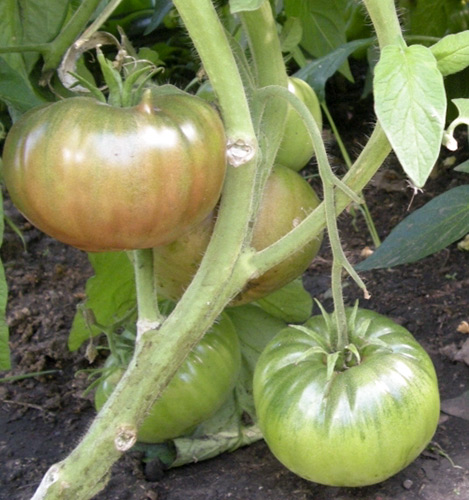
In principle, the variety is considered a salad variety, although due to its unusual dark color it sometimes looks like rotten. Still, quite often it is used not only as an ingredient for salads, but also as an element of decoration. Some people prefer to enjoy the flavor of these tomatoes without any additional ingredients because they are good on their own.
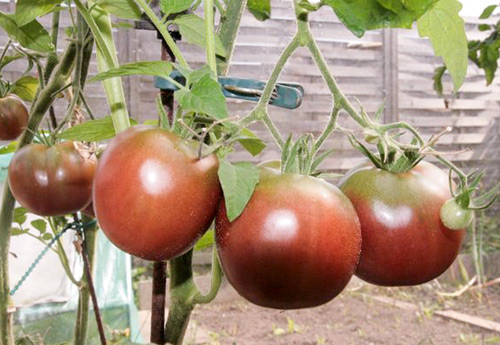
The Black Prince tomato is medium late. It is ideal for both open field and film greenhouse cultivation. If we talk about disease resistance, then its level is above average. It rarely suffers from late blight. The bushes that are planted in the form of ready-made seedlings will be stronger. Such plants have stronger immunity, allowing them to resist disease.
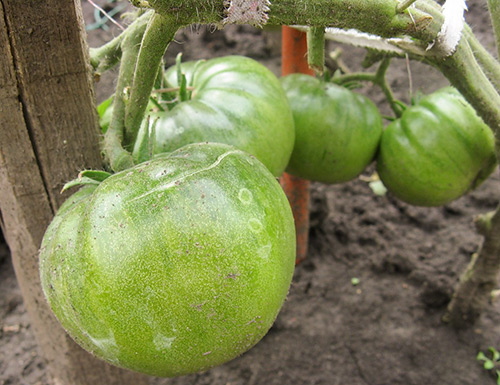
The weight of one fruit can reach 400 g. However, most often the harvest is made from tomatoes, the weight of which is 250 - 300 g. The shape of the fruit is also quite original - it can be called flat-round. The average yield of one bush is about 1.5 kg. When planting, it is imperative to observe the density standards: per 1 sq. plant no more than 2 - 3 plants per meter. The first inflorescence appears above 7 - 9 leaves, all subsequent ones - after about 3 leaves. When planting this tomato, an important requirement must be taken into account: to keep the distance from other varieties not less than one and a half meters in order to prevent over-pollination.
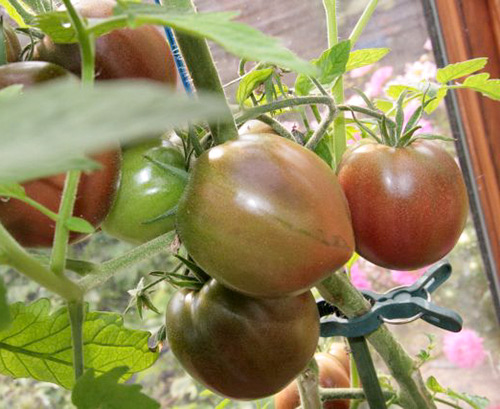
This variety is considered to be of medium height. But there are times when a bush can grow up to 2.5 meters, that is, much higher than human growth, so it requires a mandatory garter. To get a good harvest, you need a trellis. It is advisable to form a bush into one stem.
Of the negative properties of the Black Prince variety, it is most often noted that it cannot be stored for a long time. During transportation, the fruits deteriorate quickly. That is why it is advisable to eat them as soon as they are plucked from the bush.
Not all seed stores have this tomato on sale, but this is not a problem for those gardeners and gardeners who know the addresses of the most popular online stores.




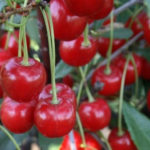




For more than five years I have been growing Black Prince tomatoes on the site. Of course, the tomato is excellent in taste and visual qualities. Its unique sweetish taste and tender fleshy flesh will win the love of even the most fastidious gourmets. But the growing process is quite painstaking. I did not succeed in growing seedlings from seeds in the open field. Since it is difficult to find seedlings on the market, I grow it myself in a small greenhouse. From 15 - 20 seeds (one sachet), on average, 7 - 12 bushes emerge. The variety is quite hygrophilous, is afraid of direct sunlight and requires an obligatory garter of the stem. Medium-sized fruits. But one day I got one bush on which tomatoes the size of a pigeon's egg grew.For the experiment, I canned a liter jar, so my husband thought it was olives)))
The Black Prince is my children's favorite strain. They pluck tomatoes straight from the bushes, peel them and eat them without anything, like apples. This variety is so self-sufficient that it does not require salt, sugar, or seasonings. Sweet, delicate, delicious. If you use it for salads, it is better to take fully ripe fruits, because greenish ones look unattractively rotten. I do not preserve it for the winter. Sometimes, in rainy weather, tomatoes of different varieties can crack. I cook tomato juice or tomato puree from them for the winter. I also add the fruits of the Black Prince, but a little, not more than 10% of the total, otherwise the color of the workpiece deteriorates.
I grow this tomato on the street, and I plant 2 - 3 bushes in a film greenhouse to get an earlier harvest. They are also sweeter in the greenhouse. Bushes always grow tall. I leave one strong bottom stepchild and form a bush into two stems. I tie it up, tear off the leaves before each brush that is tied. I process phytophthora in the same way as other varieties.
I always leave one of the first ripe tomatoes for seeds. I rip it off, keep it in the house on the windowsill for some time. I release the seeds, dry them. Everything is as usual.
About the "Black Moor". And you can find out - where exactly did you get the information that the "Black Moor" is a product of genetic engineering, but simply GMOs? You can indicate the source, I would like to learn more about this variety, since I have been growing it for several years and I have it in my favorites. And I grow it already from my own seeds.
Usually, GMO varieties are labeled as F1 hybrids, and not as a variety, and I have had cases when I planted seeds from some hybrids, which in the next generation were completely sterile (bloomed exclusively with male flowers), which indicated their GMO origin.
But that's not the case with the Moor. Therefore, I wonder - where did you get this information about the Moor? I googled the entire internet and found nothing.
We have not cooperated with the author who wrote this article for a long time. Probably one of the Chinese hybrids, which has long been no longer on sale, bore this name. The Black Moor is, of course, not a hybrid, but a common variety.
What makes you think that F1 hybrids are GMOs?)))))))) It's hard to come up with a big nonsense. This is just the first generation from crossing two different varieties. They cross forcibly, without inserting fragments into the DNA chain, but mechanically transferring pollen from the stamens of a flower of one variety to the pistil of a flower of another variety.
Alena, did you skip school biology lessons?)))
In our family, everyone loves the Black Prince tomatoes for their delicate, sweet taste. Fruits will give birth to a medium size. In the main, we eat and make tomato juice, mixing with tomatoes of other varieties. There are not many small tomatoes, but I manage to throw three or two into the jar with other tomatoes. It turns out a beautiful multi-colored twist. I grow from my seedlings, the seeds are also my own. I grow seedlings in a small greenhouse, in which I sow seeds in early April. I plant it in open ground in mid-May, I can a little earlier, guided by the fact that the sooner you plant, the sooner you collect. But it happens later, if the weather conditions do not allow. I don't water it often. The yield depends on the weather conditions of the summer, but I am not offended, there is always enough to eat.
When I was first brought to taste the fruit of the Black Prince, I really didn’t like its appearance - it looks like a tomato heavily affected by late blight. But it turned out that it has a wonderful, unlike other varieties, sweet, almost sour taste.
I specially plant this variety in partial shade, due to lack of space.And if other tomatoes in such conditions (lack of sun) are distinguished by sour fruits, the Black Prince always pleases with a small (again growing in the shade), but tasty harvest of fruits that still remain sweet.
Advantages - like many late varieties, it is very resistant to late blight, the taste of the fruit does not depend on the growing conditions. Disadvantages - requires a garter, the fruits, although tasty, are not suitable for preservation due to their loose consistency and strange appearance.
I only had to grow the Black Prince one summer, unfortunately. Because I didn't find any more seeds on sale and replaced it with other varieties. What can I say about this variety? The taste of the fruit is wonderful. I will not say that it is sweet (apparently, in the conditions of the Ivanovo region, where there is little heat and sun, it is difficult for a tomato to gain sugar content), but not sour, and this is already good for us. Grew up in my greenhouse and turned out to be under two meters, I had to tie it up. Of the shortcomings, I note that it is not very productive, other varieties give me a much larger crop in a greenhouse with the same number of seedlings. But I would gladly plant again two or three bushes in the greenhouse - it is very good for salads.
I have been planting the Black Prince from my seeds for 15 years now. 2-3 bushes. They are ideal to fill in a dark corner of the greenhouse (under the branches of the apple tree). Fruits are very well tied, the bush grows 2-2.5 meters high. They are also good in the garden, where they grow no higher than 1 meter. It is better to eat the fruits while they are just ripe, since during storage they quickly soften, so I do not plant a lot of them.
For many years I had a prejudice towards tomatoes with such an unusual color of the fruit - it seemed to me that this was unnatural for a tomato. Honestly, I was afraid - my daughter is a fan of tomatoes and I was worried about her. But I had to give up - when I first tried the Black Prince tomato, all doubts disappeared. Now this is one of the most beloved varieties - I sow first for seedlings. Plants always turn out to be strong and healthy (even the "black leg" and late blight bypasses), the variety is very productive - usually in hot and dry weather, pollination is poor, the Black Prince does not notice our heat. It's easy to care for - I let three brushes tie and shorten the top of the head, the lower stepsons root well, forming a huge bush. Tomatoes taste without sourness, tomatoes are sweet, juicy, ideal for salad.
I met the information that the Chinese authors of the Black Prince variety have brought out a new Black Prince F1 hybrid.
There is a lot of re-grading. "Timiryazevsky nursery severny branch" is packing a fake. Pay attention to the type of seeds, the Black Prince's seeds are large, greenish, with villi ..